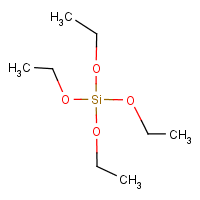Ethyl silicate
Agent Name
Ethyl silicate
Alternative Name
Tetraethylorthosilicate
CAS Number
78-10-4
Formula
C8-H20-O4-Si
Major Category
Metals

Synonyms
Tetraethylorthosilicate; Dynasil A; ES 100; ES 28; ES 28 (ester); Ethyl orthosilicate; Ethyl silicate, ((EtO)4Si); Etylu krzemian [Polish]; Orthosilicic acid, tetraethyl ester; Silane, tetraethoxy-; Silicate d'ethyle [French]; Silicate tetraethylique [French]; Silicic acid, tetraethyl ester; Silicon ethoxide; Silicon tetraethoxide; Silikan L; TEOS; TEOS (VAN); Tetraethoxysilane; Tetraethoxysilicon; Tetraethyl orthosilicate; Tetraethyl silicate; Tetraethyl-O-silicate; Tetraethylsilikat [Czech]; [ChemIDplus] UN1292
Category
Metalloid Compounds (Silicon)
Description
Colorless liquid with a sharp, alcohol-like odor; [NIOSH]
Sources/Uses
Used in mortar and surface coatings to improve resistance to weather and chemical corrosion; [ACGIH] Used in the semiconductor/electronics industry; [CSH, p. 402] Used in castings for alloys with high melting points, copper alloys, and dental prosthetic devices; Also used as a source of silicon dioxide by vapor deposition and to produce refractory bricks and heat-resistant paints; [HSDB]
Comments
Rats that survived concentrations of 400 ppm for 7 hours/day for 30 days show liver, kidney, and lung damage. [ACGIH] Causes eye irritation at 250 ppm and tearing at 1,200 ppm; [CSH, p. 402] A skin and respiratory tract irritant; Liquid defats the skin and vapor may depress consciousness; [ICSC] In high-dose animal experiments, it acts as a general anesthetic; [ChemIDplus] See "Methyl silicate."
Biomedical References
Exposure Assessment
Skin Designation (ACGIH)
Insufficient data
TLV (ACGIH)
10 ppm
PEL (OSHA)
100 ppm
MAK
10 ppm
IDLH (NIOSH)
700 ppm
Excerpts from Documentation for IDLHs
Human data: Exposure to a concentration of 1,200 ppm caused lacrimation and 250 ppm caused irritation of the eyes and nose [Smyth and Seaton 1940]. It has been stated that 700 ppm is probably intolerable for more than 30 minutes [Smyth and Seaton 1940].
Vapor Pressure
1.88 mm Hg
Odor Threshold Low
3.6 ppm
Lethal Concentration
LCLo (rat) = 1,000 ppm/4H
Explanatory Notes
Detection odor threshold from AIHA (mean = 3.6 ppm); Flash point = 99 deg F; VP from HSDB;
NFPA
may ignite at ambient temp
ERPG-1
25 ppm
ERPG-2
100 ppm
ERPG-3
300 ppm
Adverse Effects
Neurotoxin
Other CNS neurotoxin
Hepatotoxin
Hepatoxic (a) from occupational exposure (secondary effect) or (b) in animal studies or in humans after ingestion
Nephrotoxin
Yes
Diseases, Processes, and Activities Linked to This Agent
Processes
Industrial Processes with risk of exposure: